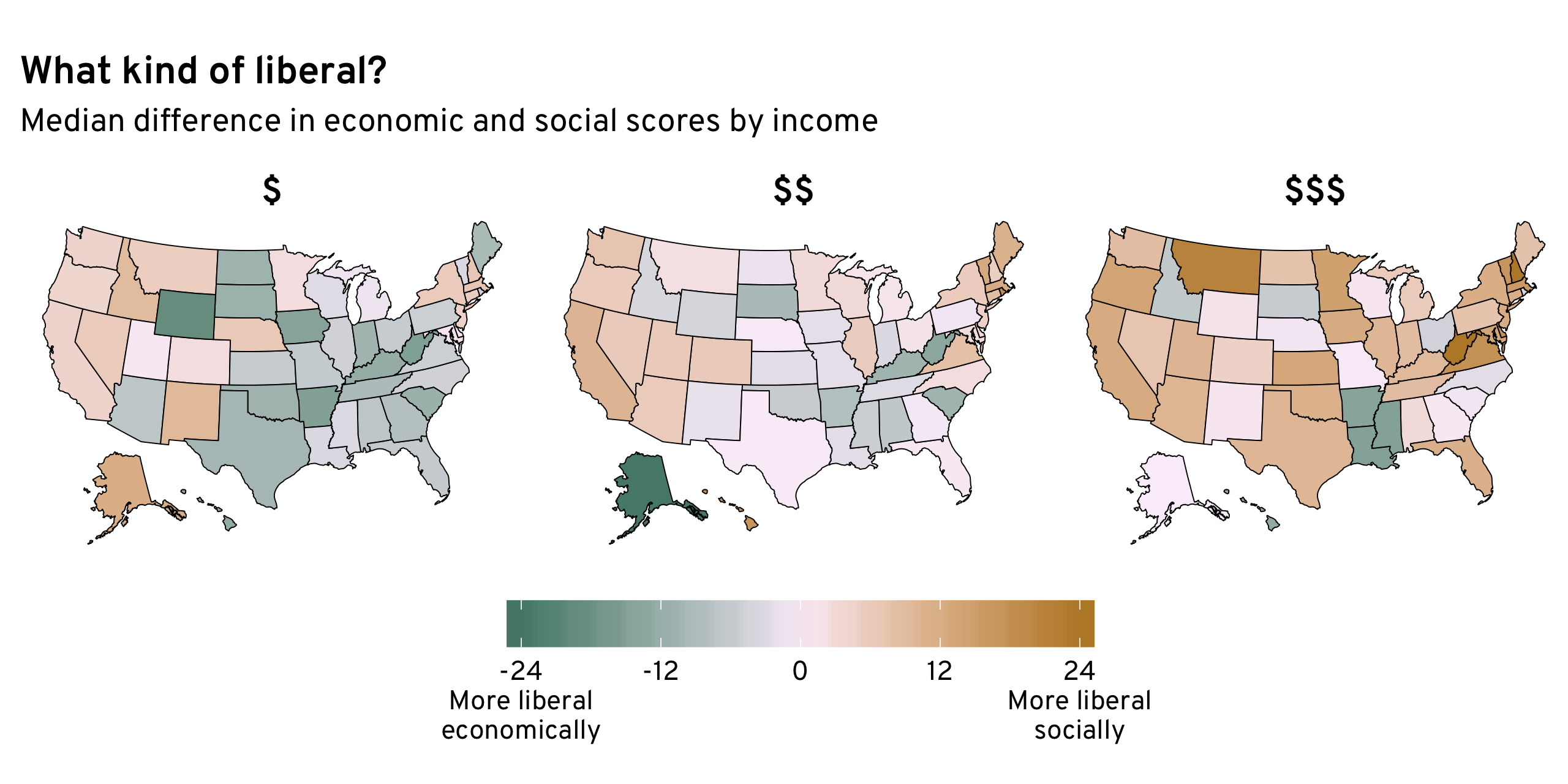I recently examined the political views of ordinary voters, and made a lot of comparisons across income groups, political parties, education, and race. One factor I didn’t look at, though, was geography. While we’re all familiar with the usual red-blue map of state partisan preference, things get a little more interesting when we look at states’ views on economic and social issues separately.
Read: Polarization and the American Electorate »
Using data from the Cooperative Congressional Election Study, which asks voters about their views on a range of policy questions, we can assign each voter a social and economic score, ranging from –100 (most liberal) to 100 (most conservative). And then we can look at how these scores vary across different states and groups.
An important point to preface things: in the interest of time, all the maps here reflect raw scores, and some subgroups in some states have relatively small sample sizes. Ideally, these scores would be input into a model which would use information in similar states to pool estimates and arrive at more robust results. So take everything here with a grain of salt.
First, we can look at how different states are politically polarized. Using the standard deviation of voters’ economic and social scores as a rough measure of polarization, we end up with the maps below. Interestingly, polarization seems to be higher in the West, and lowest in the South. Particularly liberal or conservative states (like Hawaii or Mississippi) aren’t very polarized, since much of the population is firmly in one political camp. While Utah is moderately polarized on economic issues, it is much less polarized on social issues, likely due to its relatively high religious homogeneity.


The geographic distribution of social and economic scores themselves largely follows the usual partisan patterns, but there are subtle differences. These stand out most when we compare states’ economic and social scores to each other, as in the map below. With few exceptions, states which lean Democratic are generally more socially liberal than economically liberal, while states which lean Republican are more economically than socially liberal. West Virginia has the largest gap between the two scores—it is 12.6 points more economically liberal than socially liberal. On the other end of the scale, Connecticut is 9.2 points more socially than economically liberal.

The Rust Belt states that flipped from Obama to Trump in 2016 are each more economically than socially liberal, something which may help to explain Trump’s success there. In contrast, states like Nevada and Virginia, which before the election looked to be around as close as the Rust Belt (but were ultimately won by Clinton) are more socially than economically liberal.
Previously, I had discussed how voters’ income is an important predictor of their economic and social views. How does income interact with these geographic patterns? The maps below show the average economic scores for voters in each of three income categories: $, less than $40,000 a year; $$, between $40,000 and $150,000 a year; and $$$, more than $150,000 a year. For this map and the next, it’s especially important to keep in mind that some of the sample sizes for the higher-income group are small.

Across the country, there appears to be a liberal economic consensus among lower-income voters, with little geographic variation. But among higher-income voters, there is much more polarization: wealthy voters in coastal states are far more liberal, on average, than both their counterparts in Plains and Southern states, and lower-income voters across the country.
The social score pattern is broadly similar, but again, when compared to the economic score within each state, some interesting patterns emerge. The map below shows the balance of economic and social liberalism across income groups.

In general, lower-income voters are more economically than socially liberal, while the opposite can be said of higher-income voters. And the pattern of coastal states being more socially liberal is still present. But among lower- and middle-income voters, the pattern also holds across much of the Mountain West—while Nevada and Pennsylvania are both swing states, and have a similar economic-social tilt among higher-income voters, Nevada’s lower-income voters are more socially liberal than economically liberal, while the opposite is true for Pennsylvania’s lower-income voters.
States, like individual voters, are more politically complex than the simple liberal-conservative spectrum allows. There can be important differences in the level of polarization and the type of liberalism or conservatism across otherwise similar states.